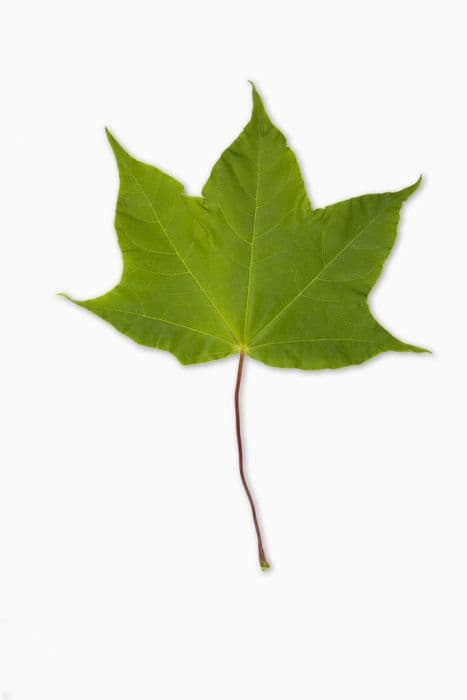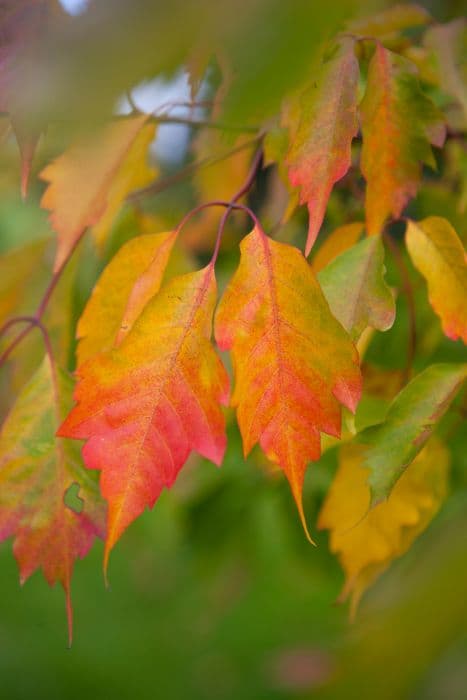Autumn Moon Japanese Maple Acer shirasawanum 'Autumn Moon'

ABOUT
Autumn Moon Maple is a captivating ornamental plant known for its unique foliage and striking colors. The leaves of this plant are the true highlights, showcasing a variety of shades throughout the seasons. In spring, the leaves emerge with a blend of yellow and orange tints, resembling the warm colors of an autumn moon as its name suggests. As they mature, these round-shaped leaves turn a deeper hue, often transforming into a rich, deep orange or red, especially when kissed by the sun's rays. The color transformation continues into the fall, when the Autumn Moon Maple puts on a spectacular show. The foliage may shift to a brighter red or a vivid scarlet, providing a fiery explosion of color in the garden. The leaves consist of multiple lobes that taper to gentle points, giving them a delicate and almost feathery appearance. The texture of the foliage is smooth, and the leaves are arranged in an outward-spreading manner, creating a full and lush profile that catches the eye. In addition to its colorful foliage, the Autumn Moon Maple may also display small, inconspicuous blooms in the spring, which later give way to winged seeds known as samaras. These seeds can often be seen twirling to the ground like tiny helicopters in the fall. The branching pattern of this plant is somewhat rounded, forming a pleasing canopy that contributes to its overall aesthetic appeal. As the seasons change, the appearance of the Autumn Moon Maple shifts, offering a dynamic and ever-changing element to any garden or landscape. Its remarkable color and form make it a sought-after variety for those looking to add a touch of seasonal beauty to their outdoor spaces.
About this plant
 Names
NamesFamily
Sapindaceae
Synonyms
Autumn Moon Japanese Maple, Shirasawa Maple
Common names
Acer shirasawanum 'Autumn Moon'.
 Toxicity
ToxicityTo humans
The Japanese Maple 'Autumn Moon' is generally not considered toxic to humans. Ingesting parts of this plant typically does not lead to poisoning or severe adverse health effects.
To pets
The Japanese Maple 'Autumn Moon' is also generally not considered toxic to pets. Ingesting parts of this plant should not cause serious health issues or symptoms of poisoning in animals like cats and dogs. However, individual animals might have varying sensitivities, so it is always prudent to watch for any signs of distress if a pet consumes plant material.
 Characteristics
CharacteristicsLife cycle
Perennials
Foliage type
Deciduous
Color of leaves
Mixed
Flower color
Varies
Height
10-15 ft (3-4.6 m)
Spread
10-15 ft (3-4.6 m)
Plant type
Tree
Hardiness zones
5-7
Native area
Japan
Benefits
 General Benefits
General Benefits- Ornamental Value: The 'Autumn Moon' Maple is highly prized for its unique and vibrant foliage that changes color throughout the seasons, providing visual interest in the landscape.
- Shade Provider: With its broad leaf canopy, it can offer a cool, shaded area in gardens and parks, making it ideal for outdoor relaxation spaces.
- Wildlife Attraction: The tree can attract birds and other wildlife, which find food and shelter in its branches.
- Compact Size: Its relatively small size compared to other maples makes it suitable for smaller gardens or limited spaces.
- Low Maintenance: Once established, it requires minimal care, making it a good choice for gardeners of all skill levels.
- Seasonal Interest: It provides year-round interest with spring flowers, summer and autumn foliage, and winter branch structure.
- Tolerates Various Soil Types: Adaptable to different soil conditions, though it prefers well-drained soil.
- Cold Hardy: It is resistant to cold temperatures, making it suitable for planting in many climates.
- Slows Erosion: Like many trees, its root system can help stabilize soil and prevent erosion.
- Enhances Property Value: Attractive landscaping, which includes feature trees like the 'Autumn Moon' Maple, can increase the value of a property.
 Medical Properties
Medical PropertiesThis plant is not used for medical purposes.
 Air-purifying Qualities
Air-purifying QualitiesThis plant is not specifically known for air purifying qualities.
 Other Uses
Other Uses- The leaves of the Autumn Moon can be used as a natural dye for fabrics, providing shades of yellow or green depending on the mordant used.
- In small quantities, the sap can be used as a base for specialty homemade inks used in art, as it provides a unique viscosity and tint.
- Wood from the Autumn Moon, when trimmed, can be utilized to make boutique woodworking projects, such as decorative boxes or picture frames, due to its fine grain.
- Pounded leaves and twigs may serve as a deterrent for pests in gardens when scattered around vulnerable plants, as some insects are averse to their scent.
- Dried and pressed leaves can be featured in botanical art pieces or used in scrapbooking for their intricate shapes and remarkable seasonal color changes.
- The Autumn Moon's distinctive foliage can be photographed through the seasons for a study in phenology, the tracking of seasonal changes in plants.
- During the fall, its vibrant leaves can be collected to create natural and biodegradable table confetti for autumn-themed events and weddings.
- The tree can be planted as part of urban forestry initiatives to increase biodiversity and add seasonal aesthetic value to city landscapes.
- With appropriate training and pruning, branches can be fashioned into living garden sculptures or arches, blending art and horticulture.
- The pattern and colors of the leaves can inspire textile designs and prints for clothing and home furnishings, appealing to nature-inspired aesthetics.
Interesting Facts
 Feng Shui
Feng ShuiThe Japanese Maple is not used in Feng Shui practice.
 Zodiac Sign Compitability
Zodiac Sign CompitabilityThe Japanese Maple is not used in astrology practice.
 Plant Symbolism
Plant Symbolism- Change and Transformation - The Acer shirasawanum 'Autumn Moon', commonly known as the Full Moon Maple, undergoes vivid color changes through the seasons, symbolizing the dynamic nature of life and the ability to transform.
- Peace and Serenity - The delicate foliage and serene presence of the Full Moon Maple in a garden setting often embodies peace and tranquil contemplation.
- Strength and Endurance - As a maple variety, Full Moon Maple represents strength and endurance due to the hardiness of the tree and its ability to withstand various climates.
- Beauty in Aging - With its spectacular autumnal color display, the Full Moon Maple is a symbol of the beauty found in maturity and the aging process.
 Water
WaterThe Autumn Moon maple should be watered deeply but infrequently, establishing a consistent watering schedule especially during its first growing season to develop a deep root system. Typically, provide about 10 to 15 gallons of water every two weeks during spring and summer, while in the fall, reduce the frequency as the rainfall usually increases and the plant's water needs decrease. During hot and dry periods, water the maple once a week. In winter, watering is often unnecessary unless there is a prolonged dry spell. It’s important not to over-water, as the tree is sensitive to waterlogged soils.
 Light
LightAutumn Moon maple thrives in partial shade to full sun. The ideal spot for this tree would offer morning sun and afternoon shade, protecting the leaves from harsh midday sun which can scorch them. It adapts well to a variety of light conditions but the leaf color is often more vibrant when the tree receives a few hours of direct sunlight each day. However, too much intense sunlight, especially in hotter climates, can damage the foliage.
 Temperature
TemperatureAutumn Moon maples grow best within a temperature range of 60 to 80 degrees Fahrenheit. Frost tolerance for this maple is quite high, and it can withstand temperatures as low as -10 to -20 degrees Fahrenheit. However, extreme heat above 90 degrees Fahrenheit can stress the tree, especially if it's in direct sunlight during the hottest part of the day. Thus, positioning the tree to avoid extreme temperatures is beneficial for its overall health.
 Pruning
PruningPruning the Autumn Moon maple is essential for maintaining its health and shape. It’s best to prune during the dormant season, typically late winter or early spring before new growth starts. Remove any dead, diseased, or crossing branches to improve air circulation. Thinning out the canopy every few years allows light to reach the interior of the tree, promoting healthy growth. Pruning should be done sparingly, as maples can bleed sap if cut too aggressively.
 Cleaning
CleaningAs needed
 Soil
SoilThe Japanese Maple 'Autumn Moon' thrives in well-draining soil that's rich in organic matter. A suitable mix would be one-part loam, one-part peat moss, and one-part pine bark with a pH between 5.5 and 6.5.
 Repotting
RepottingJapanese Maples like 'Autumn Moon' should be repotted every 2 to 3 years, ideally during their dormant period in late winter or early spring.
 Humidity & Misting
Humidity & MistingJapanese Maple 'Autumn Moon' prefers moderate humidity levels, typically between 40-60%. It does not require high humidity to thrive.
 Suitable locations
Suitable locationsIndoor
Ensure bright, indirect light and protect from drafts.
Outdoor
Plant in partial shade with shelter from strong winds.
Hardiness zone
5-7 USDA
 Life cycle
Life cycleThe life of the Autumn Moon Maple (Acer shirasawanum 'Autumn Moon') begins with seed germination, where the seeds require stratification—exposure to cold temperatures—to break dormancy. Once germinated, the seedling emerges and goes through vegetative growth, developing characteristic palmate leaves that initially display unique chartreuse tones with an underlying orange flush. As the sapling matures, it develops into a small tree, with the characteristic leaves turning vibrant shades of red and orange in the fall, giving the Autumn Moon Maple its name. The tree reaches reproductive maturity, producing flowers that are typically small and inconspicuous, followed by the development of samaras, or winged seeds, which disperse in the wind. Each year the tree will go through a seasonal cycle of growth in the spring and summer, leading to senescence of leaves in the fall and dormancy during winter months in colder climates. Throughout its life, which can span decades, the Autumn Moon Maple requires proper care, including adequate water, soil with good drainage, and full sun to partial shade to thrive and repeat its life cycle successfully.
 Propogation
PropogationPropogation time
Early Spring
The Acer shirasawanum 'Autumn Moon', commonly known as the Full Moon Maple, is best propagated through grafting, which is the most popular method for this species. This technique involves taking a small branch or bud of the 'Autumn Moon' maple and joining it to the rootstock of a more vigorous maple species. Typically, grafting is performed in late winter or early spring before the sap begins to flow. The scion, which is the piece of the Autumn Moon maple, should be dormant and have several buds. The rootstock should be actively growing to ensure the best chance of the graft taking. The scion is then carefully attached to the rootstock using a grafting technique such as whip and tongue or cleft graft, and it is held in place with grafting tape or wax. Over the course of the following growing season, the two pieces should knit together, eventually forming a single, healthy plant.









